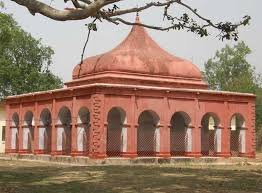Kiriteswari Temple is one of the famous temples in West Bengal which is situated in Kiritkona village under the Nabagram in Murshidabad district. It is also one of the Sati peeth amongst other 51. This place considered to be the sleeping place of Mahamaya and is more than 1000 years old. The temple is one […]
Murshidabad
Murshidabad, a district located in the eastern state of West Bengal in India, has a rich historical and cultural heritage. One of the important aspects of this heritage is the numerous temples found in this region. These temples are a testament to the artistic and architectural prowess of the people of Murshidabad and are a must-visit for anyone interested in exploring the religious and cultural traditions of the area.
The temples in Murshidabad are dedicated to various deities and are built in different architectural styles. Some of the most popular temples in the district are the Katra Masjid, the Imambara, and the Jafarganj Cemetery. The Katra Masjid is a stunning example of Mughal architecture and is renowned for its intricate designs and decorations. The Imambara, on the other hand, is a grand structure that is used for religious and social functions. The Jafarganj Cemetery, meanwhile, is a beautifully maintained burial ground that is home to the tombs of several prominent people.
Other notable temples in the Murshidabad district include the Hazarduari Palace, the Adinath Temple, and the Jagat Seth Temple. The Hazarduari Palace is a magnificent palace that has been converted into a museum and is known for its impressive collection of artifacts from the Mughal era. The Adinath Temple, on the other hand, is a Jain temple that is dedicated to Lord Adinath. It is known for its intricate carvings and is a popular destination for devotees. The Jagat Seth Temple, meanwhile, is a Hindu temple that is dedicated to Lord Vishnu and is renowned for its stunning architecture.
Visitors to Murshidabad can spend several days exploring the various temples in the district and learning about the rich history and culture of the region. The temples are not only significant religious landmarks but also provide a glimpse into the architectural, artistic, and cultural traditions of the people of Murshidabad.

